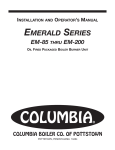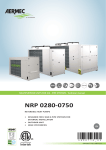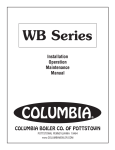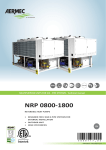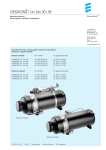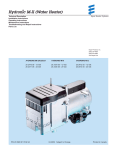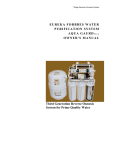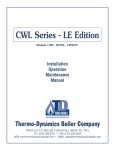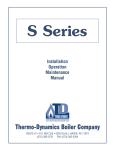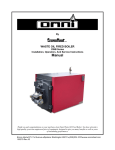Download Columbia LV Series Specifications
Transcript
LV Series Low Volume Boiler LV Boiler LVD, Direct Vent Boiler Installation Operation Maintenance Manual COLUMBIA COLUMBIA ® COLUMBIA BOILER CO. OF POTTSTOWN POTTSTOWN, PENNSYLVANIA 19464 Homeowner / Installer Policy We at Columbia Boiler Company would like to “Thank You” for choosing our top of the line LV Series Boiler. At Columbia Boiler we take pride in the serviceability and the quality construction of our products. We have built trusting relationships that date back through our company’s history to 1936. We believe that personal service is the best service and our customers agree. We would like to offer you a few helpful service points to insure your family years of trouble free comfort. In order to maintain peak performance of your boiler, it is recommended that your boiler be maintained annually. Servicing of your appliance must be performed by a qualified oil heating technician. A properly trained oil technician will be prepared to set your boiler/burner combination with the proper tools necessary to achieve your maximum comfort and efficiency. As a family owned business, we are happy to have you as one of our many satisfied homeowners who have been choosing Columbia boilers for over 70 years. We look forward to a long and continued relationship. Rosemarie Bartchak Sales and Marketing Manager Columbia Boiler Residential Sales i Product Features • • • • • • ASME Coded Boiler Registered with National Board Fully Insulated Heat Exchanger with Powder-Coated Cabinet Available with Burner Swing Door Equipped with Triple Aquastat, Circulator, and Temperature / Altitude Gauge Outfitted with Additional Nozzles to Achieve a Variety of Heat Inputs Provided with a Lifetime Limited Warranty Figure 1 Contents Homeowner / Installer Policy Product Features Model Specifications Model Dimensions Installation Operation Maintenance Trouble Shooting Preliminary Settings Parts List Burner Service Set-Up Records i 1 2 2 3 13 16 17 23 27 28 Component Arrangement A* SPECIFICATIONS LV-75 LV-100 LV-110 LV-125 LV-135 LV-150 HEATING CAPACITY BTU/HR 89,355 118,300 128,600 150,000 160,000 174,000 IBR NET RATING BTU/HR 77,700 102,900 118,000 130,500 139,100 151,300 INPUT BTU/HR 105,000 140,000 154,000 175,000 189,000 210,000 0.75 1.00 1.10 1.25 1.35 1.50 8 X 8 X 15 8 X 8 X 15 8 X 8 X 15 8 X 8 X 15 8 X 8 X 15 8 X 8 X 15 +.05 +.08 +.10 0 - +.05 0 - +.065 0 - +.08 5.5 GAL. 5.5 GAL. 5.5 GAL. 8 GAL. 8 GAL. 8 GAL. 25" 25" 25" 25" 25” 25" JACKET WIDTH 19-1/8" 19-1/8" 19-1/8” 19-1/8" 19-1/8" 19-1/8" HYDRONIC SUPPLY HEIGHT 20-1/2" 20-1/2" 20-1/2" 20-1/2" 20-1/2" 20-1/2" BURNER HEIGHT TO 9-3/8" 9-3/8" 9-3/8" 9-3/8" 9-3/8" 9-3/8" HYDRONIC RETURN HEIGHT 5" 5" 5" 5" 5" 5" FLUE OUTLET DIAMETER 5" 5" 5" 5" 5" 5" 25-1/2" 25-1/2" 25-1/2" 35" 35" 35" 5" 5" 5" 5" 5" 5" HYDRONIC SUPPLY SIZE 1-1/4" 1-1/4" 1-1/4" 1-1/4" 1-1/4" 1-1/4" HYDRONC RETURN SIZE 1-1/4" 1-1/4" 1-1/4" 1-1/4" 1-1/4" 1-1/4" 85.2 84.0 83.0 85.0 83.1 82.0 INPUT #2 OIL GPH CHIMNEY SIZE BOILER DRAFT LOSS INCHES WATER CONTENT BOILER HEIGHT w/AQUASTAT *A = JACKET DEPTH RETURN HEIGHT DOE AFUE RATING 2 Installation I GENERAL This Series hot water steel boilers are high quality oil fired heating units. The installation of the unit shall be in accordance with state and local regulations. Refer to local Installation Codes for Oil Burning Equipment, for recommended installation practice. II FREIGHT CLAIMS All units should be inspected for damage upon arrival. Concealed damage claims should be filed immediately against the carrier by the consignor. The carrier is responsible for taking prompt action on all claims. III SIZING Replacement boilers should not be sized from the firing rate of the old boiler; a DOE sponsored study indicated 65% of the heating units in U.S. homes are substantially oversized. A complete heat loss calculation of the structure is necessary to choose the proper size unit to install. The boiler should be sized to within 25% of the actual calculated heat loss of the structure. Over sizing will result in short cycling and inefficient operation. IV BOILER LOCATION A) Boiler to be installed in a level position with clearances in accordance with NFPA 31 Table 10.6.1. STANDARD CLEARANCES Model LV 75/100/110 LV125/135/150 Front 12" 24" Sides 12" 6" Rear 2" 6" Chimney Connector 2" 18" Floor Approved for installation on combustible flooring. B) Reduced clearance installations shall comply with NFPA 31 Table 10.6.2. C) To move the unit, push against the flue box or skids. Pushing or pulling the jacket or burner will result in damage. D) Be sure to level the unit by inserting shims under the elevated base. E) TANK STAND ASSEMBLY. This series of boilers can be installed on the optional tank stand in order to minimize floor space requirements when using the boiler in conjunction with an indirect fired water heater. The following procedure is required for the proper assembly of the tank stand: a) Place the stand top upside down on a level floor. b) Assemble the small cross braces by bolting them together through the center hole. Do not at this time completely tighten the bolts. 3 c) Stand two of the legs up along the short side the top on the outside of the top. Fasten the cross braces through the legs and tighten all bolts. Repeat for the other side. d) Assemble the long side braces to the legs and themselves. Place the tank stand on a level floor in its proper location before setting the boiler on top. If the floor is not level be sure to level the stand by inserting metal shims under the tank stand legs. Once the boiler is positioned on the stand do not attempt to move the stand. F) Pipe and Flange Leg Mounting. The boiler base is suplied with two holes at each corner. Circulator flanges may be installed at each corner under the base using the holes in the base and the flange bolts. Use four sections of pipe of the same length, thread at each end and screwed into the flanges at the four corners to create legs. Finish the stand by installing flanges at the ends of the threaded pipes and securing the flanges to the floor usng fasteners appropriate for the floor. The boiler may be leveled by screwing the pipes into or out of the flanges prior to securing the flanges to the floor. Item Quantity Description 1 1 Top 2 4 Legs 3 4 Large Cross Brace 4 4 Small Cross Brace 20 3/8-16 Bolts 20 3/8-16 Nuts 20 3/8-16 Washers V. AIR FOR COMBUSTION AND VENTILATION - CHIMNEY VENT APPLICATIONS The unit must be installed where provisions exist for combustion and ventilation air. Ordinarily, provisions may be furnished by the following methods. A) Utility Room or Closet In buildings of tight construction, including most modern homes, you should provide an opening, connecting to a well ventilated attic, crawl space or directly with the outdoors. The opening should have a minimum free area of 1 square inch per 1,000 Btu per hour of total input for all appliances in the enclosure and should terminate below the burner level. Boilers installed in confined areas or closets must have two ventilation openings in the closet door. Each opening should have a free area of not less than 1 square inch per 1000 Btu (140 square inch per US gph) of the total input for all appliances in the enclosure. One opening located near the top of enclosure and one near the bottom. B) Basement 1. When a boiler is installed in a full basement, infiltration is normally adequate to provide air for combustion. 2. In buildings of tight construction when the basement windows are weather stripped, one opening to a well ventilated attic or with the outdoors should be provided. (See part A for opening requirements) 4 C) Special Conditions When a boiler is located in an area where exhaust fans, kitchen ventilation systems, clothes dryers, or fireplaces may create conditions of unsatisfactory combustion or venting, special provisions should be made for additional air for combustion, as specified by local authority. VI. AIR FOR COMBUSTION AND VENTILATION - DIRECT VENT APPLICATIONS A) VENTING SYSTEM CAUTION: EXTERNAL VENT SURFACES ARE HOT. NOTE: USE ONLY THE ETL LISTED VENTING SYSTEM COMPONENTS SUPPLIED WITH THE TV-175 DIRECT VENT KIT. SURFACE DISCOLORATION OF THE BUILDING MAY OCCUR DUE TO IMPROPER BOILER/BURNER ADJUSTMENT. COLUMBIA BOILER COMPANY WILL NOT ACCEPT ANY LIABILITY FOR SUCH DISCOLORATION. Follow the instructions provided with the TV175 Direct Vent Kit for locating and installing the vent system. VII JACKET AND TRIM ASSEMBLY A) Knock Down Boiler 1. Jacket Assembly - Unpack the jacket parts being careful not to damage the finish. Piping and accessories are installed after the jacket is in place. 2. Trim Assembly a. Install the safety relief valve in the 3/4" tapping in the top of the boiler. The relief valve must be piped to a safe place of discharge. b. Install the limit control in the 3/4" fitting provided in the boiler. c. Install the altitude/temperature gauge in the 1/4" fitting provided in the coil plate. B) Packaged Boiler Controls are installed and pre-wired at the factory. Burners on models 75, 100, 110 are shipped in a separate box. To install the burner follow the burner manufacturer’s instructions included with the burner, then connect the burner to the control using the quick connect fittings that are factory installed on the control and burner harness sections. Burners on models 125, 135 and 150 are installed and pre-wired at the factory. See wiring diagram in this manual for details. Install the relief valve as noted in Section 2a. VIII BOILER PIPING This style of boiler is equipped with a built in “Air Scoop system.” This feature allows quiet air free operation of your hot water system by assuring the removal of noisy air pockets. The supply line or Riser tapping in the top of the boiler extends approximately 1" below the top or waterline of the boiler, thus allowing only air free water to enter the supply to the heating system. The air trapped in the top of the boiler is then purged through a 3/4" vent tapping to be released with an (1) automatic float vent (2) a manual vent or (3) piped into a conventional type expansion tank. 5 BUILT IN AIR SCOOP Relief valve discharges and drain valve piping must be piped to a safe place of discharge. All plugs and water connections should be checked for leaks upon installation and annually. This series of boilers virtually eliminates all standby losses with its low water content. Because this boiler is also extremely efficient a bypass loop should be installed between the supply and return of the boiler to maintain boiler water temperature during a call for heat. Consult the piping diagram in this manual for typical bypass piping. Regulation of the bypass is accomplished by use of a gate valve installed in the loop or a thermostatic bypass valve. If a gate valve is used, it should be set to the full open position initially. Final adjustment of the gate valve should be done as the system stabilizes. The valves should only be closed down enough to ensure adequate heat to all system loops. If a thermostatic bypass is used, follow the manufacturers recommendations for installation. Failure to install a bypass loop may cause excessive condensation causing premature failure of the boiler due to corrosion. IX. STORAGE TANK PIPING The recommended locations of circulators, expansion tanks, etc. are illustrated in the piping diagrams included in this manual. It is recommended that the indirect fired water heater be wired to give preference to the domestic water so that when the tank thermostat calls for heat the flow of heat to the rest of the house is turned off. Always consult the tank water heaters installation and operation manual for proper supply piping sizes, location of T & P relief valve and any other information relating to the proper installation of the tank. A thermal expansion tank may be required on those tanks which are equipped with check valves or back flow preventers on the cold water supply. X BURNER AND CONTROLS A) Burner Installations 1. Remove the burner parts and instructions from the carton. 2. Referring to specifications at the back of the manual, check to see that the burner model and size match the boiler model. 3. Make sure the correct nozzle is in place and is tightly sealed. 4. Check the electrode position and set the air intake as indicated in the burner manual. 5. The burner is installed with a mounting flange. The end of the burner air tube should be 1/4" from the inside surface of the front wall of the combustion chamber. 6. Make the electrical connections as illustrated in the wiring schematics (provided by the burner and controls manufacturer). All wiring must be done in accordance with the local electrical code. 7. For units installed in Maine, New Jersey and New York, a low-water cutoff is required on all hot water boilers. Make the electrical connections as illustrated in the wiring schematics provided by the low water cutoff manufacturer. B) Oil Primary Control - Chimney Vent (Non Post Purge Control) The oil primary control with the solid state flame sensing circuit provides automatic, non-recycling control of oil burners. When used with the cadmium sulfide flame detector, the control will automatically control the oil heating system. 6 FIGURE 2 - PIPING LAYOUT PREFERRED AND ALTERNATE METHODS CIRCULATOR AIR VENT OR EXPANSION TANK SUPPLYl m FLOW CONTROL VALVE AQUASTAT SUPPLYl FLOW CONTROL VALVE k n RELIEF VALVE n AIR VENT OR EXPANSION TANK T & A GAUGE n k THERMOSTATIC OR MANUAL BYPASS m AQUASTAT k RETURN n n ALTERNATE 1 STOP VALVE CIRCULATOR n n n n DRAIN VALVE FILL VALVE BURNER DOOR n THERMOSTATIC OR MANUAL BYPASS RELIEF VALVE n n T & A GAUGE n k RETURN STOP VALVE CIRCULATOR ALTERNATE 2 AIR VENT OR EXPANSION TANK RETURN n l AQUASTAT k n k T & A GAUGE RELIEF VALVE m n SUPPLY n FILL VALVE DRAIN VALVE n n FILL VALVE STOP VALVE n FLOW CONTROL VALVE THERMOSTATIC OR MANUAL BYPASS DRAIN VALVE BURNER DOOR PREFERRED NOTES: 1. RELIEF VALVE MUST BE PIPED TO A SAFE PLACE OF DISCHARGE. 2. AIR VENT MAY BE PIPED TO NON BLADDER TYPE EXPANSION TANK. 3. A THERMOSTATIC BYPASS VALVE OR MANUAL VALVE MUST BE USED FOR A BALANCING VALVE. 4. THE FLOW CONTROL VALVE MAY BE REPLACED BY ZONE VALVES. 5. ALL PIPING MUST COMPLY WITH ALL STATE AND LOCAL CODES. 6. CONSULT HOT WATER TANK MANUFACTURERS LITERATURE FOR TANK PIPING. 7 BURNER DOOR ELECTRICAL DIAGRAM FOR LV SERIES BOILERS TO CONNECT BURNER TO AQUASTAT (APPLIES TO BECKETT CHIMNEY VENT BURNERS) ELECTRICAL DIAGRAM FOR LV SERIES BOILERS TO CONNECT BURNER TO AQUASTAT (APPLIES TO RIELLO CHIMNEY VENT BURNERS) 8 ELECTRICAL DIAGRAM FOR LV SERIES BOILERS TO CONNECT BURNER TO AQUASTAT (APPLIES TO CARLIN CHIMNEY VENT BURNERS) ELECTRICAL DIAGRAM FOR LVD SERIES BOILERS TO CONNECT BURNER TO AQUASTAT (APPLIES TO BECKETT DIRECT VENT BURNERS) 9 ELECTRICAL DIAGRAM FOR LVD SERIES BOILERS TO CONNECT BURNER TO AQUASTAT (APPLIES TO RIELLO DIRECT VENT BURNERS) ELECTRICAL DIAGRAM FOR LVD SERIES BOILERS TO CONNECT BURNER TO AQUASTAT (APPLIES TO CARLIN DIRECT VENT BURNERS) 10 The primary control will stop the oil burner within a predetermined number of seconds if the fuel fails to ignite or if the flame goes out during operation. The oil burner will remain off until the reset button on the relay has been pushed. THE RESET MUST NEVER BE PRESSED MORE THAN ONCE DURING A SINGLE FLAME FAILURE. C) Oil Primary Control - Direct Vent (Post Purge Control) The oil primary control with the solid state flame sensing circuit provides interrupted ignition. Used in conjunction with a cadmium sulfide flame detector, the control will automatically control the oil burner. The primary control will stop the oil burner within a predetermined number of seconds if the fuel fails to ignite or if the flame goes out during operation. The oil burner will remain off until the reset button on the relay has been pushed. THE RESET MUST NEVER BE PRESSED MORE THAN ONCE DURING A SINGLE FLAME FAILURE. Post-purge is provided to ensure that the boiler fires at maximum efficiency and dependability throughout the heating season. Post-purge of the oil burner is controlled through the electronic circuitry supplied. Post-purge timing is variable. The factory set post-purge timing is at approximately one minute. It is recommended that it be left at this setting. In no case should the post purge timing be reduced to less than 1 minute. Length of Vent Kit 0 - 10 Feet 10.1 - 15 Feet 15.1 - 20 Feet Minimum Post Purge Time 1 Minute 1 Minute 2 Minutes Times are approximate and should be considered minimum settings for the length of intake pipe installed. The length of post-purge may be increased on those units using the Beckett AFII or Riello BF-5 oil burners to any value up to its maximum setting if field conditions require a longer purge cycle. The length of post-purge on the Carlin burner is not adjustable. The post purge timing on the Carlin burner is 90 seconds. D) Aquastat This control is installed in one of two locations shown in the Component Arrangement. The control provides a high limit function and circulator control. See the control manufacturers wiring diagrams and literature for more information concerning wiring and use options. See wiring diagram in this manual for details. XI. SEQUENCE OF OPERATION When room temperature or the indirect water heater temperature falls below the thermostat setting, the thermostat calls for heat starting the burner and circulating pump. The burner and pump continue to operate until room heating requirements are satisfied. If the boiler high limit is reached the burner will shut off with the circulator continuing to operate. If the thermostat continues to call for heat after the boiler temperature falls below the high limit setting the burner will restart. 11 It is recommended that the indirect water heater be wired so that when its thermostat calls for heat the flow of heat to the rest of the house is turned off. Consult the wiring diagrams from the indirect hot water heater manufacturer for wiring details. XII FUEL SYSTEM A) Fuel Units NOTE: Pump pressure 140 PSI for Beckett and Carlin, and 150 PSI for Riello. 1. Burners are commonly fitted with a single stage fuel unit. A single stage unit may be connected with a supply line only, when the fuel supply is level with or above the burner. When the burner is above the oil level, a return line should be provided between the fuel unit and the tank. A “by-pass” plug in the fuel unit is then required. The return line automatically purges air from fuel units and returns it to the tank. 2. Two stage fuel unit. If the height difference between the burner and the fuel supply level exceeds 10 ft., a two stage unit should be used, and a return line should be installed. B) Tubing Use continuous heavy walled copper tubing with flare fittings only. Locate fittings in accessible locations. If possible, tubing should be installed under the floor. Running tubing against boiler casings or across ceiling or floor joints should be avoided. C) In-Line Oil Filter The oil filter should be of a generous capacity. It should be located inside the building between the tank shut off valve and the burner. A shut off valve and the oil filter should be located as close to the burner as possible for ease of servicing. D) Oil Shut Off Valve Install manual oil shut off valves at the burner and near the tank on the supply line. Both valves should be easily accessible. XIII FLUE SYSTEM - CHIMNEY VENT APPLICATIONS A) General AN OIL FIRED UNIT SHALL BE CONNECTED TO A FLUE HAVING SUFFICIENT DRAFT AT ALL TIMES TO ASSURE PROPER OPERATION. B) Draft The draft regulator should be installed in accordance with the manufacturers instructions. Set the draft to negative .02 to .04 inches W.C. in the stack. C) Roof Clearances The flue gas exit of the venting system should be at least 3 feet above the highest point where it passes through the roof and at least 2 feet higher than any portion of a building with 10 feet of the venting system. D) Chimney Connectors The horizontal length of a chimney connector should not exceed 10 feet unless a draft booster is used. The connector should be pitched upward at least 1/4 inch to the foot. Use only high quality lock seam smoke pipe. Each joint should be securely fastened with sheet metal screws. Chimney connectors should be positioned to the shortest possible run of smoke pipe to the chimney. 12 E) Vent Cap Install a U.L. listed vent cap where the possibility of down drafts exist. F) Boiler Venting This boiler must be vented into a properly sized chimney, or into an Underwriters Laboratories Inc. listed venting device which is capable of maintaining the specified draft requirements. As indicated in this manual, chimney sizes, draft requirements and other additional service and installation requirements are essential for safe and proper operation of the boiler. Only a trained experienced serviceman should attempt the installation or service of any boiler and or venting device. All venting installations must comply with the recommendations of the venting manufacturer and with all state and local codes. XIV WIRING All external wiring must conform with the National Electric Code and local codes. Refer to burner and controls manufacturer’s wiring diagrams for field wiring. A) Field connections should be protected with a 15 amp fuse. B) Install the room thermostat on an inside wall away from cold drafts, windows, or heat from fireplaces, appliances, or sunlight. Connect the thermostat leads to the “TT” terminals on the circulator control. XV WARRANTY The limited warranty is not applicable unless these installation instructions are followed. Operation I START UP DO NOT START UNLESS CLEAN OUT DOORS ARE IN PLACE. A. Make sure service switch to boiler is off. B. Make sure boiler has been filled with enough water until the entire system has been purged and desired pressure is obtained. C. Check to make sure the oil storage tank is filled with No. 2 heating oil. D. Make sure all manual shut off valves in the fuel system are open. E. Set limit switch at 200°F. F. Install a pressure gauge in the 1/8" gauge port, or bleed valve port of the fuel pump. The pressure should be set per Installer/Serviceman Label. G. Adjust the burner air band and air shutter in accordance with Installer/serviceman Label. H. Push the safety reset button on the primary control and release. Adjust the thermostat to call for heat. Turn the service switch to the on position. Bleed the fuel unit. If burner fails to start, refer to the trouble shooting guide in this manual. I. With the burner running, bleed the fuel unit again until all air is eliminated from lines. Close and tighten the bleed port. J. Check all lines and plugs for oil leaks and eliminate. 13 II START UP ADJUSTMENTS A) 1. 2. 3. 4. 5. Equipment Required CO2 analyzer Draft gauge. Fuel pressure gauge. Stack thermometer. Smoke tester. B) Burner Adjustments Allow the burner to operate steadily for at least 15 minutes. Check the burner settings according to the installer/serviceman label for your model, printed at the end of this manual, and make the following adjustments: 1. Sampling Hole - punch 1/4" hole in the flue between the flue box and the draft regulator. All test readings should be taken from this point. 2. In The Stack Draft - Take a draft reading from the flue pipe sampling hole. Adjust the barometric draft regulator to -.02" in the stack. In tall chimneys a second draft regulator may be required in the flue pipe to regulate draft under high draft conditions. 3. Overfire Draft - Take a draft reading from the draft port located to the left of the burner. Compare the readings with those according to the installer/serviceman labels for Series I and II boilers starting on page 30. Reinstall the draft port plug after all readings have been taken. 4. Pump Pressure - Adjust the pump discharge pressure per value on serviceman label. 5. Combustion Air - Reduce the air supply to allow just sufficient air for clean combustion. This is accomplished by loosening the lock screws on the air shutter, and closing the air shutter until a trace of smoke is recorded. Take a CO2 sample. Open the air shutter lowering CO2 about 1-1/2% to 2%. A zero smoke reading should result. If this adjustment cannot be obtained, refer to the trouble shooting section in this manual. C) Instructing the Homeowner The care and operation of the boiler should be explained to the homeowner, including care of the burner, how to adjust the thermostat, necessity of air supply to the burner, and the simple checks to make before calling the serviceman if the burner fails to operate automatically. III BURNER SERVICING A) Burner Components If a replacement part is necessary, use only the part specified on the burner parts list in this manual. Specify the part number and description when ordering. (See included burner literature). B) Nozzles Use only the correct nozzle specified on the “Installer/Serviceman” decal located on front boiler jacket. Be extremely careful not to touch the nozzle orifice to avoid scratches or dirt which may cause leaks or affect the oil spray pattern. C) Electrode Settings The electrode setting is critical for proper ignition of the fuel. Check to be sure electrode settings comply with the specifications. 14 D) Fan and Blower Housing The fan and blower housing should be kept clean from lint and dirt. If the boiler is located near an unvented dryer, special care must be taken so that lint does not block air passages in the burner and proper combustion air is provided. IV HOMEOWNER INFORMATION Your Serviceman/Service Company is: Address: Phone No.: A) General Never burn garbage or refuse in your heating unit. Never try to ignite oil by tossing burning papers or other material into your boiler and never leave combustible material around it. Do not allow the fuel tank to run out of oil. The fuel tank should be kept full during the summer or periods of non-use, to prevent condensation of moisture on the inside of the tank. B) Combustion Air Supply Your burner requires an ample amount of clean combustion air in order to completely and efficiently burn fuel. If an ample supply is not available erratic operation, noisy combustion, and fuel odors in the air may result. Remember that venting fans or a vented dryer will greatly increase the need for outside air. C) Filter Replace the cartridge filter in the line every year to avoid fuel unit and nozzle contamination. D) Area Around Boiler The area around the boiler should be kept clean and free of any combustible materials, particularly oily rags or papers. The boiler should be accessible for ease of service. If the burner is shut down for an extended period of time, shut off the manual fuel supply valve. Follow starting procedures to restart. V SERVICE INFORMATION To avoid unnecessary expense and inconvenience, the boiler and burner should be inspected at least once a year by a qualified serviceman. If difficulty occurs, the following should be observed before calling the serviceman. A) B) C) D) Check to be sure there is fuel in the tank. Check to see if the thermostat setting is above room temperature. Check to see if the service switch is in the on position. Do not tamper with the unit or its controls. 15 Maintenance I VENT SYSTEM ESCAPING GASES ARE DANGEROUS. THE ENTIRE FLUE AND VENTING SYSTEM SHOULD BE INSPECTED AT LEAST ONCE A YEAR BY A QUALIFIED SERVICEMAN. II OIL FILTER The oil filter cartridge should be replaced annually. III CLEANING At the beginning of each heating season, boiler flue passages and the oil burner should be checked for cleanliness and if necessary they should be cleaned. The boiler may be cleaned from either the front or rear by removing the jacket panel and the front or rear door. The following procedure is required for inspection and cleaning of the boiler flue passages. A) Turn off all electrical power to the boiler before inspecting and cleaning. B) Remove either the boiler front or rear jacket panel. C) Remove the 8 brass nuts which hold on the door. The front door swings open for access. The rear door must be completely removed. D) Remove the fire tube baffles. E) If required remove scale and any soot deposits with a flexible 2” flue brush. Be careful not to damage the front or rear insulation. F) Replace the fire tube baffles. G) Reinstall the door and tighten with the 8 brass nuts. H) Reinstall the jacket panel. I) Turn on all electrical power to the boiler. DO NOT REMOVE THE REAR COVER AND REAR REFRACTORY FOR NORMAL MAINTENANCE. SOOT OR SCALE MUST BE REMOVED FROM THE FRONT BURNER OPENING ONLY. IV OIL BURNER A) Thoroughly brush clean the burner fan blades. Only with clean fan blades is proper combustion air delivery possible. B) Clean nozzle assembly and all air handling parts. C) Check spacing and condition of the ignition electrodes. D) Nozzles should be inspected every year for plugged distributor slots or plugged orifices. If it is necessary to replace the nozzle, use only the specified nozzle to be sure that the replacement meets the spray pattern specifications of the burner. V GASKETS Tighten the nuts on the water coil annually to prevent any gasket leaks. Deterioration due to coil gasket leaks shall void the warranty. VI WIRING Check the electrical wiring for damage or frayed insulation. 16 Troubleshooting Guide TROUBLE: BURNER DOES NOT START SOURCE PROCEDURE CAUSES REMEDY Thermostat Check Thermostat Thermostat set too low. Turn thermostat up. Thermostat on “off ”or “cool.” Switch to heat. Open thermostat wires. Repair or replace wires. Loose thermostat connectors. Tighten connection. Faulty thermostat. Replace thermostat. Thermostat not level. Level thermostat. Check burner motor overload switch. (If equipped) Burner motor tripped on overload. Push reset button. Check primary control safety switch. Primary tripped on safety. Reset safety switch. Check boiler disconnect switch and main disconnect switch. Switch open. Close switch. Tripped breaker or blown fuse. Reset breaker or replace fuse. Jump the FF terminals on primary control, if the burner starts, fault is in detector circuit. Open cad cell wires. Repair or replace wire. Dirty cell face. Clean or replace face. Faulty cad cell. Replace cad cell. Check resistance across cad cell. If 400-600 ohms cell is bad. Replace cad cell. Check for line voltage between the black and white leads. No voltage indicates no power to the control. Limit control switch open Check limit setting. Circuit Overloads Power Cad Cell Primary Control Burner Jump terminals - if burner starts replace control. Open circuit between limit control and disconnect switch. Repair circuit. Low line voltage or power failure Call utility company. Check for line voltage between orange and white leads. No voltage indicates a faulty control. Defective control. Replace control. Check for voltage at the black and white leads to the burner motor. Voltage indicates power to motor and a fault in the burner. Pump seized. Turn off power to burner. Rotate blower by hand, check for excessive drag. Replace fuel unit or blower wheel. Blower wheel binding. Burner motor defective. When checking burner adjustments always use instruments. 17 Replace burner motor. TROUBLE: BURNER STARTS BUT DOES NOT ESTABLISH FLAME SOURCE PROCEDURE CAUSES REMEDY Oil Supply Check tank for oil. Empty tank. Fill tank. Check for water in oil tank using a dip stick coated with litmus paste. Water in oil tank. Strip tank of water exceeding 2" in depth. Listen for pump whine. Fuel supply valve closed. Open valve. Open pump bleed port and start burner. Milky oil or no oil indicates loss of prime. Air leak in fuel system. Repair leak, using only flared fittings. Do not use Teflon tape on oil fittings. Listen for pump whine. Oil filter plugged. Replace filter cartridge. Plugged pump strainer. Clean Strainer. Restriction in oil line. Repair oil line. Pump worn - low pressure. Motor overloads. Replace pump. Coupling worn or broken. Replace coupling. Pump discharge pressure set too low. Set pressure according to the installer/serviceman labels for Series I & II boilers located at the end of this manual. Oil Line and Filter Oil Pump Install pressure gauge in port of fuel pump. Pressure should be according to the installer/ serviceman labels for Series I & II boilers located at the end of this manual. No spark or weak spark. Ignition Transformer Ignition Electrodes Nozzle Connect transformer leads to line voltage. Listen for spark. Check that transformer terminals are not arcing with buss bars. Check that transformer is properly grounded. Line voltage below 102V. Remove and inspect drawer assembly. Carboned and shorted electrodes. Clean electrodes. Eroded electrode tips. Incorrect electrode settings. Replace and reset electrodes. Cracked porcelain insulators. Replace and reset electrodes. Plugged orifice or distributor. Replace nozzle with nozzle according to the installer/ serviceman labels for Series I & II boiler located at the end of this manual. Check for faulty nozzle. Call utility company. Plugged nozzle strainer. Poor spray pattern. Combustion Air Adjustments Replace transformer. Inspect nozzle for correct size and specifications. Incorrect nozzle installed. Install correct nozzle. See “Burner Adjustment Instructions” in this manual. Air shutter open too far. Decrease air shutter setting. Air band open too far. Decrease air band opening. When checking burner adjustments always use instruments. 18 TROUBLE: BURNER FIRES, BUT THEN FAILS ON SAFETY SOURCE PROCEDURE CAUSES REMEDY Cad Cell Check cad cell with ohmmeter. If more than 2000 ohms, cad cell is defective or dirty. Faulty or dirty cad cell Clean or replace cad cell. Primary Control After burner fires, open cad cell circuit if flame looks OK. If burner continues to operate, fault is in primary control. Faulty primary control Replace primary control. Heat Exchanger Restriction Inspect heat exchanger. Plugged heat exchanger. Clean out heat exchanger. Burner Motor Burner motor trips on overload. Turn off power and rotate blower by hand to check for excessive drag. Line voltage below 102V Call utility company. Faulty motor. Replace motor. Pump or blower overloading motor. Replace blower or pump. TROUBLE: TOO MUCH HEAT SOURCE PROCEDURE CAUSES REMEDY Circulator Check to see if operating control is working properly. Circulator does not stop running. Repair operating control. Thermostat Check thermostat settings and calibration. Thermostat set too high. Reset thermostat. Thermostat defective Replace thermostat. Thermostat out of calibration. Recalibrate. Check level. Flow valve dirty and stuck. Clean flow valve. Flow valve defective. Replace flow valve. Flow Valve Check to see if flow valve is operating properly. When checking burner adjustments always use instruments. TROUBLE: HIGH NET STACK TEMPERATURES SOURCE PROCEDURE CAUSES REMEDY Nozzle Check pump pressure with pump gauge. Nozzle overfiring due to high pump pressure. Reduce pump pressure according to installer/serviceman labels for Series I & II boilers located at the end of this manual. Heat Exchanger Check heat exchanger surfaces for soot or scale fouling. Heat exchanger fouled. Clean heat exchanger. Baffles Check baffles installed. Baffles not installed. Install baffles. 19 TROUBLE: BURNER FIRES, BUT THEN LOSES FLAME SOURCE PROCEDURE CAUSES REMEDY Poor Fire Inspect flame for stability. Unbalanced fire. Replace nozzle with specified nozzle. Excessive draft. Reduce draft setting. Insufficient draft. Increase draft. Insufficient combustion air sources. Increase combustion air sources. Air leak in fuel system. Repair leak - use only flare fittings. Water in oil tank. Strip tank of water exceeding 2" in depth. Fuel supply valve closed. Open valve. Restriction in oil line. Clear oil line restriction. Plugged fuel filter. Replace filter cartridge. Plugged pump strainer. Clean Strainer. Cold oil. Use #1 heating oil. Oil Supply If burner loses flame prior to the primary control locking out, fault is in fuel system. Combustion Air Reduce combustion air supply. Too much combustion air. Close air band and air to raise CO2. Check with instruments. Pump Install pressure gauge in gauge port of fuel pump. Pressure should be according to installer/ serviceman labels for Series I & II boilers located at the end of this manual. Pump discharge pressure incorrectly set. Set pressure according to installer/serviceman labels for Series I & II boilers located at the end of this manual. Coupling worn or broken. Replace coupling. Pump worn - low pressure motor overloads. Replace pump. Excessive Draft Take a draft reading. Draft should be according to installer/serviceman labels for Series I & II boilers located at the end of this manual. Incorrect draft setting. Reduce setting. Install second draft regulator if necessary. Poor Flue Gas Sample Insert CO2 probe into heat exchanger tube. If reading is greater by 1/2% or more, sample was being diluted near flue box. Leak in flue system. Sample CO2 in heat exchanger. Testing Method Using a chemical absorption type device, let instrument set after a test before venting. If CO2 reading increases 1/2% fluid is weak. Weak fluid. Replace fluid in testing device. Nozzle Check for faulty nozzle. Plugged orifice or distributor. Replace nozzle with specified nozzle. Seal flue system leak. Plugged nozzle strainer. Poor spray pattern. When checking burner adjustments always use instruments. 20 TROUBLE: BURNER FIRES, BUT PULSATES SOURCE PROCEDURE CAUSES REMEDY Draft Take a draft reading. Draft should be according to installer/ serviceman labels for Series I & II boiler located at the end of this manual, in the stack. Down drafts. Install vent cap. Insufficient draft. Increase draft setting. Excessive draft. Reduce draft settings, install second draft regulator if necessary. Draft Regulator Inspect draft regulator for correct location on flue system. Improper installation. Move draft regulator to correct location. Combustion Air See Table 1. Inspect installation for combustion air provisions. Improper installation. Provide sufficient sources of air for combustion. Open air band wide and take CO2 reading. Improper adjustment. Adjust CO2 level - start with air band wide open. Use instrument. Bleed pump; inspect for air leaks or water contamination. Air leak in fuel system. Compression fittings. Repair leak - use only flare joints. Water in oil tank. Strip tank of water exceed 2" in depth. Install pressure gauge in gauge port of fuel pump. Pressure should be according to installer/ serviceman labels for Series I & II boiler located at the end of this manual. Pump discharge pressure incorrectly set. Set pressure according to installer/serviceman labels for Series I & II boiler located at the end of this manual. Coupling worn or broken. Replace coupling. Pump worn - low pressure motor overloads. Replace pump. Check for faulty nozzle. Plugged orifice or distributor. Replace nozzle with nozzle specified on burner housing. Oil Supply Pump Pressure Nozzle Plugged nozzle strainer. Poor spray pattern. Heat Exchanger Restrictions Inspect heat exchanger. Plugged heat exchanger. When checking burner adjustments always use instruments. 21 Clean out heat exchanger. TROUBLE: INSUFFICIENT HEAT SOURCE PROCEDURE CAUSES REMEDY Circulator Check if circulator is operational. Coupling worn or broken. Replace coupling. Pump binding. Replace pump. Circulator motor burned out. Replace circulator motor. Wiring from operating control defective. Repair wiring. Operating control defective. Repair or replace operating control. Check if circulator is correct size. Circulator too small. Replace with proper circulator. Check if circulator is up to speed; check if voltage to circulator is sufficient. Circulator defective. Repair circulator. Insufficient voltage. Call utility company. Check thermostat settings. Settings too low. Increase setting. Check thermostat location. Bad location due to heat build up. Move thermostat to a better location. Check thermostat calibration. Out of calibration. Recalibrate. Level thermostat. Flow Valve Check flow valve for sticking in partially closed position. Flow valve not opening fully. Clean or replace flow valve. Radiation Check for air in radiators. Radiators airbound. Bleed radiators. Check to see if radiators are sized properly. Radiators inadequate. Install adequate radiation. Boiler Determine structure heat load. Boiler too small. Additional heating capacity. Piping Check to see if piping is sized properly. Piping inadequate. Install adequate piping. Heat Exchanger Check heat exchanger for soot or scale accumulation. Insufficient heat transfer. Clean heat exchanger. Burner Check pump pressure with pressure gauge. Insufficient pump pressure. Increase pressure according to installer/serviceman labels for Series I & II boilers located at the end of this manual. Nozzle Check nozzle for size and spray angle. Wrong nozzle installed. Install specified nozzle. Check for faulty nozzle. Nozzle underfiring due to defective nozzle. Replace nozzle. Thermostat 22 Preliminary Settings INSTALLER/SERVICEMAN INSTALLER/SERVICEMAN Model Number Burner Type Model Number LV-75 LV-100 LV-110 ________________________ Riello Riello Burner Type Riello ZERO Beckett Beckett AFII AFII AFII ________________________ Nozzle Type .65 70B .85 70B .90 70B ________________________ Pump Pressure PSI ________________________ 140 140 140 Head/Pin Position ________________________ 0 0 3 Air Band 2.0 3.75 4.5 ________________________ Air Shutter N/A N/A N/A ________________________ Draft Over Fire 0 to +.1" 0 to +.1" 0 to +.1" ________________________ Draft In Stack -0.02" -0.02" -0.02" ________________________ CO2 Reading 10-11.5% 10-11.5% 10-11.5% ________________________ F5 F5 F5 ________________________ Nozzle Type .65 60W .85 60w .90 60W ________________________ Pump Pressure PSI ________________________ 150 150 150 Head/Pin Position ________________________ 2.0 2.0 2.0 Air Band N/A N/A N/A ________________________ Air Shutter 1.75 3.0 3.25 ________________________ Draft Over Fire +0.02" +0.03" +0.06" ________________________ Draft In Stack -0.02" -0.02" -0.02" ________________________ CO2 Reading 10-11.5% 10-11.5% 10-11.5% ________________________ ZERO Beckett Burner Model Burner Model Smoke Reading LV-75 LV-100 LV-110 ________________________ Smoke Reading ZERO ZERO ZERO ZERO NOTICE Above settings are approximate. Final adjustments to be made with proper test equipment. Be sure all oil lines are air free and the use of flare fittings is recommended. See installation/service manual for detailed information. NOTICE Above settings are approximate. Final adjustments to be made with proper test equipment. Be sure all oil lines are air free and the use of flare fittings is recommended. See installation/service manual for detailed information. INSTALLER/SERVICEMAN INSTALLER/SERVICEMAN Model Number Burner Type LV-75 LV-100 LV-110 ________________________ Carlin Carlin Model Number Carlin Burner Type Burner Model EZ-1 EZ-1 EZ-1 ________________________ Nozzle Type .65 60°A .85 60°A .90 60°A ________________________ Pump Pressure PSI ________________________ 140 140 140 Head/Pin Position ________________________ 0.75 0.85-1.00 1.10-1.25 Air Band 0.60 0.85 0.75 ________________________ Air Shutter N/A N/A N/A ________________________ Draft Over Fire 0 to +.1" 0 to +.1" 0 to +.1" ________________________ Draft In Stack -0.02" -0.02" -0.02" ________________________ CO2 Reading 10-11.5% 10-11.5% 10-11.5% ________________________ Burner Model Smoke Reading Smoke Reading ZERO ZERO LV-75 LV-100 LV-110 ________________________ Beckett Beckett Beckett AFG AFG AFG ________________________ Nozzle Type .65 80A .85 80A .90 80A ________________________ Pump Pressure PSI ________________________ 140 140 140 Head/Pin Position ________________________ F-3* F-4 F-6 Air Band 1 1 1.5 ________________________ Air Shutter 10 OPEN 10 OPEN 10 OPEN ________________________ Draft Over Fire 0 to +.1" 0 to +.1" 0 to +.1" ________________________ Draft In Stack -0.02" -0.02" -0.02" ________________________ CO2 Reading 10-11.5% 10-11.5% 10-11.5% ________________________ ZERO ZERO ZERO ZERO *Equipped with low firing rate baffle. AFG burners standard with delay oil valve. NOTICE Above settings are approximate. Final adjustments to be made with proper test equipment. Be sure all oil lines are air free and the use of flare fittings is recommended. See installation/service manual for detailed information. NOTICE Above settings are approximate. Final adjustments to be made with proper test equipment. Be sure all oil lines are air free and the use of flare fittings is recommended. See installation/service manual for detailed information. 23 INSTALLER/SERVICEMAN Model Number Burner Type INSTALLER/SERVICEMAN LV-75 LV-100 LV-110 ________________________ Beckett Beckett Model Number Beckett Burner Type Burner Model Riello NX NX NX ________________________ Nozzle Type .60 60°B .75 60°B .85 60°B ________________________ Pump Pressure PSI ________________________ 175 175 175 Head/Pin Position ________________________ 2.5 3.5 4.0 Air Band N/A N/A N/A ________________________ Air Shutter N/A N/A N/A ________________________ Draft Over Fire +0.000" +0.050" +0.080" ________________________ Draft In Stack -0.020" -0.020" -0.020" ________________________ CO2 Reading 10-11.5% 10-11.5% 10-11.5% ________________________ Burner Model Smoke Reading Smoke Reading ZERO ZERO LVD-75 LVD-100 LVD-110 ________________________ Riello Riello BF5 BF5 BF5 ________________________ Nozzle Type .65 60W .85 60W .90 60W ________________________ Pump Pressure PSI ________________________ 150 150 150 Head/Pin Position ________________________ 2.0 2.0 2.0 Air Band N/A N/A N/A ________________________ Air Shutter 3.25 4.25 4.5 ________________________ Draft Over Fire 0 to +.10" 0 to +.10" 0 to +.10" ________________________ Draft In Stack -0.02" -0.02" -0.02" ________________________ CO2 Reading 10-11.5% 10-11.5% 10-11.5% ________________________ ZERO ZERO ZERO ZERO NOTICE Above settings are approximate. Final adjustments to be made with proper test equipment. Be sure all oil lines are air free and the use of flare fittings is recommended. See installation/service manual for detailed information. NOTICE Above settings are approximate. Final adjustments to be made with proper test equipment. Be sure all oil lines are air free and the use of flare fittings is recommended. See installation/service manual for detailed information. INSTALLER/SERVICEMAN INSTALLER/SERVICEMAN Model Number Burner Type LVD-75 LVD-100 LVD-110 ________________________ Beckett Beckett Model Number Beckett Burner Type Burner Model Carlin* AFII AFII AFII ________________________ Nozzle Type .65 70B .85 70B .90 70B ________________________ Pump Pressure PSI ________________________ 140 140 140 Head/Pin Position ________________________ 0 0 3 Air Band 2.0 3.75 4.5 ________________________ Air Shutter N/A N/A N/A ________________________ Draft Over Fire 0 to +.1" 0 to +.1" 0 to +.1" ________________________ Draft In Stack -0.02" -0.02" -0.02" ________________________ CO2 Reading 10-11.5% 10-11.5% 10-11.5% ________________________ Burner Model Smoke Reading Smoke Reading ZERO ZERO LVD-75 LVD-100 LVD-110 ________________________ Carlin* Carlin* EZ-1 EZ-1 EZ-1 ________________________ Nozzle Type .65 60°A .85 60°A .90 60°A ________________________ Pump Pressure PSI ________________________ 140 140 140 Head/Pin Position ________________________ 0.75 0.85-1.00 1.10-1.25 Air Band 0.50 0.85 0.75 ________________________ Air Shutter N/A N/A N/A ________________________ Draft Over Fire 0 to +.1" 0 to +.1" 0 to +.1" ________________________ Draft In Stack -0.02" -0.02" -0.02" ________________________ CO2 Reading 10-11.5% 10-11.5% 10-11.5% ________________________ ZERO ZERO ZERO ZERO *Requires Carlin Air Intake Adapter NOTICE Above settings are approximate. Final adjustments to be made with proper test equipment. Be sure all oil lines are air free and the use of flare fittings is recommended. See installation/service manual for detailed information. NOTICE Above settings are approximate. Final adjustments to be made with proper test equipment. Be sure all oil lines are air free and the use of flare fittings is recommended. See installation/service manual for detailed information. 24 INSTALLER/SERVICEMAN INSTALLER/SERVICEMAN Model Number Burner Type Model Number LVD-75 LVD-100 LVD-110 ________________________ Beckett Beckett Burner Type Beckett ZERO Riello Riello F5 F5 F5 ________________________ Nozzle Type 1.00 60A 1.10 60A 1.25 60A ________________________ Pump Pressure PSI ________________________ 150 150 150 Head/Pin Position ________________________ 2.0 3.0 4.0 Air Band N/A N/A N/A ________________________ Air Shutter 3.5 3.75 6.25 ________________________ Draft Over Fire +0.05" +0.07" +0.09" ________________________ Draft In Stack -0.02" -0.02" -0.02" ________________________ CO2 Reading 10-11.5% 10-11.5% 10-11.5% _______________________ NX NX NX ________________________ Nozzle Type .60 60°B .75 60°B .85 60°B ________________________ Pump Pressure PSI ________________________ 175 175 175 Head/Pin Position ________________________ 2.0 3.5 4.0 Air Band N/A N/A N/A ________________________ Air Shutter N/A N/A N/A ________________________ Draft Over Fire +0.045" +0.100" +0.125" ________________________ Draft In Stack -0.025" -0.030" -0.075" ________________________ CO2 Reading 10-11.5% 10-11.5% 10-11.5% ________________________ ZERO Riello Burner Model Burner Model Smoke Reading LV-125 LV-135 LV-150 ________________________ Smoke Reading ZERO ZERO ZERO ZERO NOTICE Above settings are approximate. Final adjustments to be made with proper test equipment. Be sure all oil lines are air free and the use of flare fittings is recommended. See installation/service manual for detailed information. NOTICE Above settings are approximate. Final adjustments to be made with proper test equipment. Be sure all oil lines are air free and the use of flare fittings is recommended. See installation/service manual for detailed information. INSTALLER/SERVICEMAN INSTALLER/SERVICEMAN Model Number Burner Type LV-125 LV-135 LV-150 ________________________ Carlin Carlin Model Number Carlin Burner Type Burner Model EZ-1 EZ-1 EZ-1 ________________________ Nozzle Type 1.00 60B 1.10 60B 1.25 60B ________________________ Pump Pressure PSI ________________________ 140 140 140 Head/Pin Position ________________________ 1.1/1.25 1.35/1.5 1.35/1.5 Air Band 1.25 1.35 1.50 ________________________ Air Shutter N/A N/A N/A ________________________ Draft Over Fire 0 to +.1" 0 to +.1" 0 to +.1" ________________________ Draft In Stack -0.02" -0.02" -0.02" ________________________ CO2 Reading 10-11.5% 10-11.5% 10-11.5% ________________________ Burner Model Smoke Reading Smoke Reading ZERO ZERO LV-125 LV-135 LV-150 ________________________ Beckett Beckett Beckett AFG AFG AFG ________________________ Nozzle Type 1.00 45B 1.10 45B 1.25 45B ________________________ Pump Pressure PSI ________________________ 140 140 140 Head/Pin Position ________________________ V-1 V-1 V-1 Air Band CLOSED 1.5 2 ________________________ Air Shutter 10 OPEN 10 OPEN 10 OPEN ________________________ Draft Over Fire 0 to +.1" 0 to +.1" 0 to +.1" ________________________ Draft In Stack -0.02" -0.02" -0.02" ________________________ CO2 Reading 10-11.5% 10-11.5% 10-11.5% ________________________ ZERO NOTICE Above settings are approximate. Final adjustments to be made with proper test equipment. Be sure all oil lines are air free and the use of flare fittings is recommended. See installation/service manual for detailed information. ZERO ZERO ZERO NOTICE Above settings are approximate. Final adjustments to be made with proper test equipment. Be sure all oil lines are air free and the use of flare fittings is recommended. See installation/service manual for detailed information. 25 INSTALLER/SERVICEMAN INSTALLER/SERVICEMAN Model Number Burner Type Model Number LV-125 LV-135 LV-150 ________________________ Beckett Beckett Burner Type Beckett ZERO Smoke Reading ZERO INSTALLER/SERVICEMAN Burner Type LVD-125 ________________________ Beckett Burner Model NX ________________________ Nozzle Type 0.90 45°B ________________________ Pump Pressure PSI ________________________ 175 Head/Pin Position ________________________ 20. Air Band N/A ________________________ Air Shutter N/A ________________________ Draft Over Fire +0.170" ________________________ Draft In Stack +0.000" ________________________ CO2 Reading 10-11.5% ________________________ Smoke Reading Riello ZERO ZERO ZERO *Requires Carlin Air Intake Adapter NOTICE Above settings are approximate. Final adjustments to be made with proper test equipment. Be sure all oil lines are air free and the use of flare fittings is recommended. See installation/service manual for detailed information. NOTICE Above settings are approximate. Final adjustments to be made with proper test equipment. Be sure all oil lines are air free and the use of flare fittings is recommended. See installation/service manual for detailed information. Model Number Carlin* AFII EZ-1 BF5 ________________________ Nozzle Type 1.00 60°B 1.00 60°B 1.00 60°B ________________________ Pump Pressure PSI ________________________ 140 140 150 Head/Pin Position ________________________ 8 110-125 1.0 Air Band N/A N/A N/A ________________________ Air Shutter 5.0 1.25 6.00 ________________________ Draft Over Fire 0 to +0.2" 0 to +0.2" 0 to +0.2" ________________________ Draft In Stack 0 to +0.1" 0 to +0.1" 0 to +0.1" ________________________ CO2 Reading 10-11.5% 10-11.5% 10-11.5% _______________________ NX NX NX ________________________ Nozzle Type 0.90 45°B 1.00 45°B 1.10 45°B ________________________ Pump Pressure PSI ________________________ 175 175 175 Head/Pin Position ________________________ 2.0 2.5 3.0 Air Band N/A N/A N/A ________________________ Air Shutter N/A N/A N/A ________________________ Draft Over Fire +0.070" +0.120" +0.200" ________________________ Draft In Stack -0.020" -0.020" -0.020" ________________________ CO2 Reading 10-11.5% 10-11.5% 10-11.5% ________________________ ZERO Beckett Burner Model Burner Model Smoke Reading LVD-125 LVD-125 LVD-125 ________________________ ZERO NOTICE Above settings are approximate. Final adjustments to be made with proper test equipment. Be sure all oil lines are air free and the use of flare fittings is recommended. See installation/service manual for detailed information. 26 Parts List LV75/110 and LV125/150 Boilers Item No. 1 2 3 4 5 Not Shown Not Shown Not Shown 6 7 Description Heat Exchanger Fire Tuber Baffle Combustion Liner Insulation for Steel Burner Door Burner Door Steel Burner Door, Cast Door Complete Insulation for Cast Burner Door Cast Frame Gasket Target Wall Insulation Rear Door Part Number LV75/110 280000 280275 337804 337803 280264 280260 337810 337811 337816 280269 Part Number LV125/150 280002 280274 337804 337803 280264 280260 337810 337811 337816 280269 8 9 10 11 12 13 14 15 22 Front Jacket Panel Rear Jacket Panel Left Jacket Panel Right Jacket Panel Top Jacket Panel Aquastat Temperature/Altitude Gauge Relief Valve Circulator 501070 501080 501100 501090 501065 552110 559560 570180 535030 Kit 502280 27 552110 559560 570180 535030 BURNER SERVICE SET-UP RECORDS Initial Set Up 1 2 3 4 5 1. Date 2. Model Number 3. Firing Rate 4. Pump Pressure* 5. CO2 6. “0” Smoke 7. Gross Stack°F 8. Draft Over Fire 9. Replaced Filter Yes/No 10. Replaced Nozzle Yes/No 11. Clean Pump Filter Yes/No 12. Inspect Coil Gasket 13. Check for Leaks @ plugs/fittings 14. Brush Clean Flue Tube Passages 15. Vacuum Chamber/Flue Tubes 16. Clean Blower Wheel 17. Check/Set Electrodes *See pump pressure according to the installer/serviceman labels for Series I and II boilers located at the end of this manual 28 BURNER SERVICE SET-UP RECORDS 6 7 8 9 10 1. Date 2. Model Number 3. Firing Rate 4. Pump Pressure* 5. CO2 6. “0” Smoke 7. Gross Stack°F 8. Draft Over Fire 9. Replaced Filter Yes/No 10. Replaced Nozzle Yes/No 11. Clean Pump Filter Yes/No 12. Inspect Coil Gasket 13. Check for Leaks @ plugs/fittings 14. Brush Clean Flue Tube Passages 15. Vacuum Chamber/Flue Tubes 16. Clean Blower Wheel 17. Check/Set Electrodes *See pump pressure according to the installer/serviceman labels for Series I and II boilers located at the end of this manual 29 BURNER SERVICE SET-UP RECORDS 11 12 13 14 15 1. Date 2. Model Number 3. Firing Rate 4. Pump Pressure* 5. CO2 6. “0” Smoke 7. Gross Stack°F 8. Draft Over Fire 9. Replaced Filter Yes/No 10. Replaced Nozzle Yes/No 11. Clean Pump Filter Yes/No 12. Inspect Coil Gasket 13. Check for Leaks @ plugs/fittings 14. Brush Clean Flue Tube Passages 15. Vacuum Chamber/Flue Tubes 16. Clean Blower Wheel 17. Check/Set Electrodes *See pump pressure according to the installer/serviceman labels for Series I and II boilers located at the end of this manual CC-5106 01/08 - 250
































